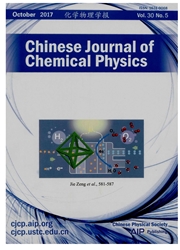

 中文摘要:
中文摘要:
利用三种方法可视化化了Ru(II)ammine的金属到配体的电荷转移.首先原子分辨的态密度显示HoM0上的密度主要在Ru上,LUMo上的态密度在ammine上,这说明Ru上激发的电子会转移到ammine配体上.第二,电荷差异密度揭示了所有的窄穴都在Ru上,所有的电子都在ammine上.第三,跃迁密度矩阵揭示了Ru和Hammine上的电子空穴对的相关性.这三种方法也用来研究Os(bpy)2(pop)Cl的金属到配体的电荷转移和Alq3配体到配体的电荷转移.
 英文摘要:
英文摘要:
Three methods including the atomic resolved density of state, charge difference density, and the transition density matrix are used to visualize metal to ligand charge transfer (MLCT) in ruthenium(II) ammine complex. The atomic resolved density of state shows that there is density of Ru on the HOMOs. All the density is localized on the ammine, which reveals that the excited electrons in the Ru complex are delocalized over the ammine ligand. The charge difference density shows that all the holes are localized on the Ru and the electrons on the ammine. The localization explains the MLCT on excitation. The transition density matrix shows that there is electron-hole coherence between Ru and ammine. These methods are also used to examine the MLCT in Os(bpy)2(p0p)Cl ("Osp0p": bpy=2,2-bipyrldyl; p0p=4,4'- bipyridyl) and the ligand-to-ligand charge transfer (LLCT) in Alq3. The calculated results show that these methods are powerful to examine MLCT and LLCT in the metal-ligand system.
 同期刊论文项目
同期刊论文项目
 同项目期刊论文
同项目期刊论文
 Optical Properties of Neutral and Charged Low Band Gap Alternating
Copoly°uorenes: TD-DFT Investigat
Optical Properties of Neutral and Charged Low Band Gap Alternating
Copoly°uorenes: TD-DFT Investigat Photoexcitation mechanisms of centrosymmetric and asymmetric fluorine derivatives in two-photon abso
Photoexcitation mechanisms of centrosymmetric and asymmetric fluorine derivatives in two-photon abso Tunable Electronic Structures and Optical Properties of Fluorenone-Based Molecular
Materials by Hete
Tunable Electronic Structures and Optical Properties of Fluorenone-Based Molecular
Materials by Hete Theoretical study on contribution of charge transfer effect to surface-enhanced Raman scattering spe
Theoretical study on contribution of charge transfer effect to surface-enhanced Raman scattering spe EXCITED-STATE INTRAMOLECULAR ELECTRON TRANSFER COUPLED WITH EXCITED-STATE INTRAMOLECULAR PROTON TRAN
EXCITED-STATE INTRAMOLECULAR ELECTRON TRANSFER COUPLED WITH EXCITED-STATE INTRAMOLECULAR PROTON TRAN Time-dependent Density Functional Theory Study on the Hydrogen-bonded Dimers Formed by Gauche-1PA an
Time-dependent Density Functional Theory Study on the Hydrogen-bonded Dimers Formed by Gauche-1PA an STUDY OF THE S(1) AND S(2) EXCITED STATES OF GAS-PHASE PROTONATED SCHIFF BASE RETINAL CHROMOPHORES I
STUDY OF THE S(1) AND S(2) EXCITED STATES OF GAS-PHASE PROTONATED SCHIFF BASE RETINAL CHROMOPHORES I Can p,p′-Dimercaptoazobisbenzene Be Produced from p-Aminothiophenol by Surface Photochemistry Reacti
Can p,p′-Dimercaptoazobisbenzene Be Produced from p-Aminothiophenol by Surface Photochemistry Reacti Local and Remote Charge-Transfer-Enhanced Raman Scattering on One-Dimensional Transition-Metal Oxide
Local and Remote Charge-Transfer-Enhanced Raman Scattering on One-Dimensional Transition-Metal Oxide Experimental and theoretical evidence for the chemical mechanism in SERRS of rhodamine 6G adsorbed o
Experimental and theoretical evidence for the chemical mechanism in SERRS of rhodamine 6G adsorbed o Can information of chemical reaction propagate with plasmonic waveguide and be detected at remote te
Can information of chemical reaction propagate with plasmonic waveguide and be detected at remote te Quasi-one dimensional Er3+-Yb3+codoped single-crystal MoO3 ribbons: Synthesis characterization and u
Quasi-one dimensional Er3+-Yb3+codoped single-crystal MoO3 ribbons: Synthesis characterization and u The pH-Controlled Plasmon-Assisted Surface Photocatalysis Reaction of 4-Aminothiophenol to p,p0-Dime
The pH-Controlled Plasmon-Assisted Surface Photocatalysis Reaction of 4-Aminothiophenol to p,p0-Dime Direct visual evidence for chemical mechanisms of SERRS via charge transfer in Au20-pyrazine-Au20 ju
Direct visual evidence for chemical mechanisms of SERRS via charge transfer in Au20-pyrazine-Au20 ju Near- and Deep-Ultraviolet Resonance Raman Spectroscopy of Pyrazine-Al4 Complex and Al3-Pyrazine-Al3
Near- and Deep-Ultraviolet Resonance Raman Spectroscopy of Pyrazine-Al4 Complex and Al3-Pyrazine-Al3 Self-assembled dynamics of silver nanoparticles and self-assembled dynamics of 1,4-benzenedithiol ad
Self-assembled dynamics of silver nanoparticles and self-assembled dynamics of 1,4-benzenedithiol ad S1 and S2 excited states of Gas-Phase Schiff-Base Retinal Chromophores: A Time-Dependent Density Fun
S1 and S2 excited states of Gas-Phase Schiff-Base Retinal Chromophores: A Time-Dependent Density Fun 期刊信息
期刊信息
